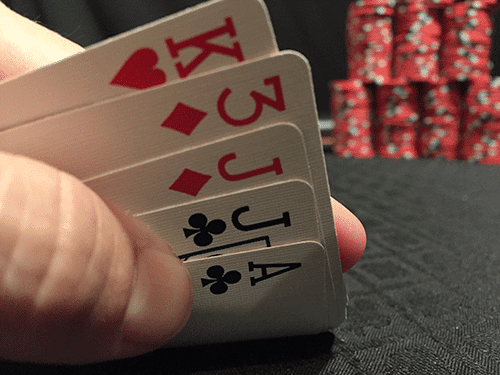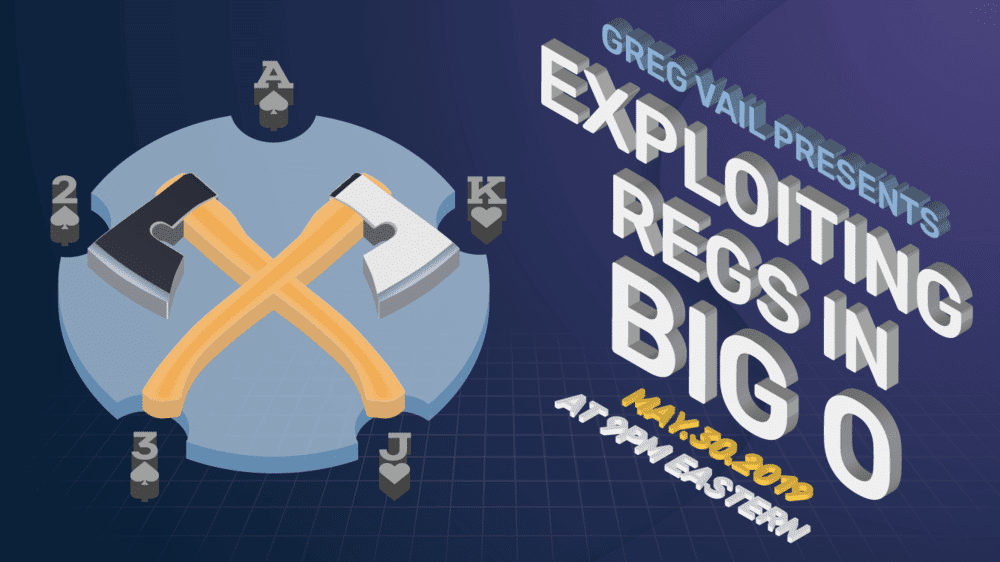Whether you’ve never heard of Big O, heard stories about the unmatched action, huge games in the Pacific Northwest and California, or maybe you’ve seen the large amounts of Big O games running at the WSOP or even heard about six tables of 5/5 Big O running daily at the SA Card House in San Antonio, you probably are wondering what all the fuss is about? Maybe you’re wondering what it takes just to start learning this seemingly complicated game.
You’re right, Big O does seem complicated from the outside looking in. Everyone gets five down cards and there are two different pots in the same hand. You may be one of those players who has never looked at more than two down cards in your entire Holdem playing life. Regardless of what game you are coming from, this will serve as a guide on how to start, where to look, and what resources to pick up if you are interested in getting into a Big O game.

The first thing I recommend is to pick up a copy of Scoop! Big O and PLO8: Winning High Low Concepts for the Holdem Mind. I wrote this book with the specific intention of tailoring it to you, the Holdem playing mind, so you can learn Big O in terms you can understand. This book gets right to the point by telling you the exact concepts you need to know to be successful in making the transition from Holdem to Big O. It routinely makes Holdem analogies and discusses math in a way that Holdem players can relate to. If you are a PLO player, it will help you as well since I assume that everyone reading the book already knows how to play Holdem.
After you have read Scoop!, here a few more helpful concepts to learn and resources for you to get started making the transition from Holdem:
1) Start watching the concept and hand history videos I have produced for the Red Chip Poker PRO library.
These videos break down the core concepts that must be understood if you are to be successful at the Big O table. Concepts that are also explained in detail in Scoop! such as the Key Card Concept, Transparency, and most importantly, Redefining the Best Hand.
2) Make sure that you fully and completely understand what the “best hand” is.
This is so important that I put it on the very first page of Scoop!. You must understand that the best hand in poker is the hand with the best chance to win, not the hand that is “ahead” right now. In Holdem, these two things are usually true at the same time. In Big O, this is RARELY true. If Player A has 10 outs to scoop going to the River and Player B has 27 outs to scoop and 4 outs to chop, who has the best hand? Obviously, Player B has the best hand, but if I told you that Player A has the current nut Set on the Turn and Player B doesn’t have a pair, would you still agree Player B has the best hand? You should. This is the number one reason why Holdem players struggle so much at Big O when making the transition.
3) Understand that the number one thing that Holdem players complain about, splitting pots, is what makes this game so exploitable.
Because of the split pot, you can play a significant amount of your Big O hands with very little or no actual financial risk. Sounds crazy right? In Holdem, you are always risking 100% of your wagers to win 100% of the pot. Obviously, there are a few rare exceptions like Flopping a Straight Flush, but most of the time, if we play a hand of Holdem, we are going to win 100% of the pot or we are going to lose 100% of what we wager. This is not true in Big O. Most of the time, we are risking 50%, 25%, or even 0% of our wager to win 50%, 75%, or even 100% of the pot. Take this hand for example: We Flop a nut Low with a Flush draw and our opponent has nothing but the nut Straight. We are risking 0% of all wagers to win 100% of the pot. We are guaranteed to win 50% of the pot since we have the Low already locked up and we will win 100% of the pot if we make a Flush and beat the Straight.
This concept is explained in detail in Scoop! and my instructional videos in Red Chip’s library so please study up if this requires more explanation. You know how cool it is to Flop the nut Straight and a Flush draw in Holdem, and find out that your opponent has the same Straight and no draws? If you’re playing Big O correctly, this will happen multiple times a session. If splitting pots irritates you or you think it isn’t a good thing, you’re doing it wrong. Wouldn’t it be nice to play Holdem in a way that every time you were drawn out on the River or missed your draw, you got back 25% or 50% of the pot instead of losing all of it? That would make it pretty hard to have a losing session wouldn’t it? That’s Big O (if you are playing correctly).
For all of you PLO players out there that are wondering what it takes to go from four card High only to Five card High Low, here are a few tips for you to make the transition easier:
1) Pick up a copy of Scoop! and check out Red Chip Poker’s video library on Big O.
2) Learn that although you are used to a naturally high variance game in PLO, there is a much easier way of doing things in Big O.
PLO players are used to identifying small equity situations, thin advantages, and taking aggressive, high variance lines against opponents. These things are simply not necessary to have success in Big O and most of the time, can even be detrimental to your success. Your opponents will routinely put large amounts of money in on the Turn and River when they are drawing stone dead to 50%, 75%, or even 100% of the pot without knowing it. Why would we want to get tons of money in Pre-Flop or even on the Flop when we have 55%-60% equity? We can, but we simply don’t have too. Try and wait until later in the hand to get large amounts of money in when players make a nut hand that is dead to half or less to get stacks in rather than attempting to exploit thin equity situations early in the hand.
3) Stop three and four betting Pre-Flop with a vast majority of the hands you play.
I fully understand the value of taking control of a hand, especially in position, and gaining the momentum in a single pot game, but Big O is not a single pot game. For much the same reasons mentioned in the previous point, there is much more value in waiting until later in the hand to bloat the pot and get stacks in, especially when we are in position on the field. Granted, there are always exceptions to this, which are discussed in Scoop!, but as a general rule of thumb, it benefits us more to flat raises in position and keep our range much more opaque (hidden, nontransparent, cloudy) Pre-Flop in Big O than it does to routinely hammer everything playable and narrow down the field to one or two opponents. We make much more money in a split pot game when more players put more money in getting 0% of the pot, not necessarily by wagering more money ourselves and being called once.
Consider this example: We are first to act playing a $1000 stack on the River. There is $1000 in the pot and we have nut/nut against five players. If we rip all the money in right now, are called once, and double up, we win $1000 plus the $1000 in the middle. If we instead bet $300 and are called by all five players, we win $1500 plus the $1000 in the middle. If we had three or four bet Pre-Flop and taken our hand heads up, we wouldn’t get this opportunity and the amount we could win would be severely capped. Remember, the goal is to win more money, not more pots.
If PLO8 or fixed limit O8 is your game and you are looking to make the transition to Big O, you may already be familiar with most of the concepts you need to succeed, but there are a few things to study up on to make life easier with five cards;
1) A small mistake in PLO8 is a catastrophic nightmare in Big O.
This usually refers to overplaying hands that are easy to beat or easy to exploit such as naked nut Straights, Straights that play a Nine in your hand, or one-way hands from out of position. Sometimes, we can get away with this in PLO8 without much damage, but when everyone has five cards, it is likely you’re going to be punished for the max.
Remember, a nut Straight can be split four ways, so can the nut Low. Also, a Flopped nut Straight can be as much as an 11-1 underdog to finish as the nut Straight. Keep the basics described in Scoop! in mind and try your best not to overplay these types of hands in Big O, especially from out of position.
2) Fixed limit players need to start from scratch.
Pretend Big O is a totally different game than fixed limit O8, because it is! Fixed limit has the comfort of capped betting. You can only win and lose so much and a mistake likely is only going to cost you an additional half or full bet. If you make the exact same mistake in Big O, it could cost you half or your entire stack.
3) Fixed limit players MUST learn to take it easy on raising with the naked nut Low and a couple of non-nut draws.
This is the perfect way to learn a very hard lesson for a very large amount of money. Fixed limit players may be used to raising in spots where they believe they have one pot made and could have draws to the entire pot. They know they are only risking one additional bet if they are wrong, but if this is done lightly in Big O, that same hand could get an entire stack stuffed back in their face and lose everything in front of them. Bottom line is step lightly and think twice about pressing the action with a nut Low only and a couple non-nut draws because an error could cost an entire stack rather than one or two additional bets.
Big O is very different to most other forms of poker. Big O is to Holdem as Chess is to Checkers. It is more complicated, more skillful, and requires a completely different mindset and approach to win consistently. Follow these guidelines and directions and you’ll be well on your way to huge win rates and massive pots.
If you would like to take a more direct and expedited approach to learning Big O, please contact me directly for Big O coaching at Gregvailpoker@gmail.com. Mention this article and I will credit you with one free hour of coaching with the purchase of eight hours or more.

Exploiting Regs In Big O Group Coaching Session
We’ll be digging deeper into Big O during the May Red Chip Poker group coaching session. As usual there will be plenty of time to ask questions on the material covered in the presentation and related areas of poker.
Here are the details:
Time: 9pm ET
Date: May 30, 2019
Please note, the event is available exclusively to PRO members of the Red Chip Poker training site. Look forward to catching you there! PRO members can register directly from their PRO dashboard.
Now is also a great time to upgrade to PRO if you haven’t already. Replay previous group coaching sessions, get complete access to CORE, the entire PRO video library, every Crash Course, and more.

Sounds fantastic! I’m going to upgrade to Pro for this.